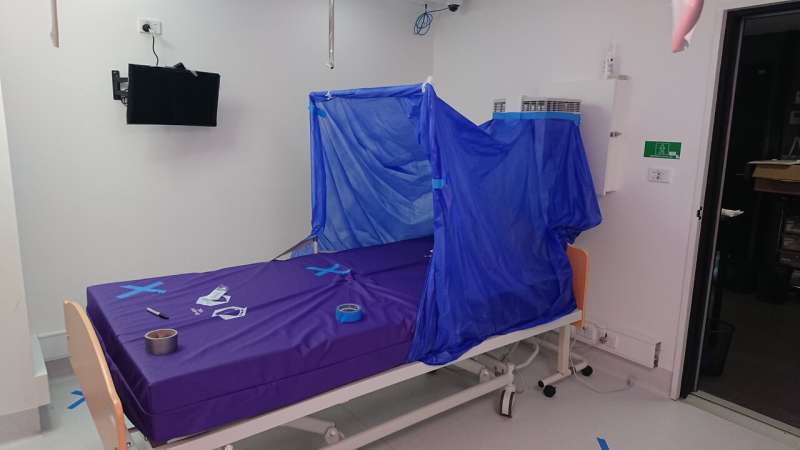Ventilated headboard hood, combined with HEPA air filter. (C) Simon Joosten
A new study by Monash University provides evidence that a simple ventilated headboard hood can stop the spread of SARS-CoV2 between patients and health care workers in hospital wards.
The research published in the European Respiratory Journal, led by research fellows Dr. Simon Joosten from Monash School of Clinical Sciences and Dr. Shane Landry from Monash Biomedicine Discovery Institute, is the first study of its kind to track the flow of airborne virus particles in a sealed 'phage dome' testing room.
The study found that when a mask used to deliver oxygen/ventilation to a patient leaks, it actually causes healthcare workers to be exposed to virus particles. Even low amounts of leak greatly elevated the risk. However, with the use of a ventilated headboard hood, combined with a HEPA air filter in place, the problem is eliminated, which could help health care workers stay safe.
"Our study showed that when a mask used to deliver non-invasive ventilation leaks, it can lead to viruses escaping and landing on basically every surface in a room, even up to 3.86 meters away. This has major safety considerations for open wards and could explain the increased risk of infections in healthcare workers," said Dr. Joosten.
"We were really surprised and pleased by just how effective our very cheaply constructed ventilated headboard worked. To test it, we released 1 billion viruses into the hood and not a single one escaped," Dr. Landry said.
With Victoria's healthcare workers accounting for 10 percent of second wave cases and infections on the rise overseas, researchers are hoping this new evidence will give hospitals worldwide a cheap and simple intervention that doesn't require major infrastructure changes, and will improve quality of care and save lives.
Currently, COVID-19 patients requiring life saving oxygen/ventilation treatments can only be safely administered this intervention in a negative pressure isolation room, in order to mitigate aerosol spread risk. As an example, Monash Medical Centre is typical of Australian tertiary hospitals in that it has eight such single negative pressure rooms, and therefore the hospital's capacity to deliver ward-based oxygen/ventilation treatment is critically limited.
In Australian hospitals with finite negative pressure room resources, there is the real risk of these rooms being overwhelmed and unavailable during an outbreak. This results in a reluctance to provide oxygen/ventilation treatments to patients who may otherwise benefit, resulting in inferior care which could lead to death.
Health care workers are already at higher risk of infection than the general population. In this context, it's unsurprising that they are reluctant to place themselves at further risk by treating patients with oxygen/ventilation outside of negative pressure rooms. Besides the obvious need to provide safe workplaces to all individuals, health care workers themselves are a vital healthcare resource, with temporary leave due to infection placing increasing strains on our public health system.
"Viable virus aerosol propagation by positive airway pressure (PAP) circuit leak and mitigation with a ventilated patient hood" is published in the European Respiratory Journal.
More information: European Respiratory Journal (2020). DOI: 10.1183/13993003.03666-2020
Journal information: European Respiratory Journal
Provided by Monash University























